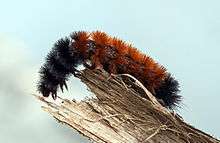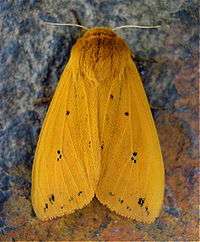Pyrrharctia isabella
Pyrrharctia isabella, the isabella tiger moth, banded woolly bear or just woollybear or woolly worm, occurs in the United States and southern Canada.[1][2][3] The first European to describe it was James Edward Smith in 1797.
| Isabella tiger moth | |
|---|---|
.jpg) | |
| Adult | |
 | |
| Woollybear caterpillar | |
| Scientific classification | |
| Kingdom: | Animalia |
| Phylum: | Arthropoda |
| Class: | Insecta |
| Order: | Lepidoptera |
| Superfamily: | Noctuoidea |
| Family: | Erebidae |
| Subfamily: | Arctiinae |
| Genus: | Pyrrharctia |
| Species: | P. isabella |
| Binomial name | |
| Pyrrharctia isabella (J. E. Smith, 1797) | |
| Synonyms | |
| |
Appearance
The thirteen-segment larvae are usually covered with brown hair in their mid-regions and black hair in their anterior and posterior areas. In direct sunlight, the brown hair looks bright reddish brown. Adults are generally dull yellowish through orangish and have robust, scaly thorices; small heads; and bright reddish-orange forelegs. Wings have sparse black spotting.
The isabella tiger moth can be found in many cold regions, including the Arctic. The banded woolly bear larva emerges from the egg in the fall and overwinters in its caterpillar form, when it literally freezes solid. First its heart stops beating, then its gut freezes, then its blood, followed by the rest of the body. It survives being frozen by producing a cryoprotectant in its tissues.[4] In the spring it thaws.
Larval setae do not inject venom and are not urticant; they do not typically cause irritation, injury, inflammation, or swelling.[5] Handling larvae is discouraged, however, because their sharp, spiny hairs may cause dermatitis in some people.[6] When disturbed, larvae defend themselves by playing possum (rolling up into balls and remaining motionless) and quickly crawling away.
 Head of a caterpillar
Head of a caterpillar Adult
Adult
Diet
This species is a generalist feeder, consuming many plant species, including herbs and trees.[7] Based on the caterpillars’ wide range of food plants, this moth could be found almost anywhere that plants grow.[8]
Related species
Singer et al showed that the larvae of a related moth, Grammia incorrupta (whose larvae are also called "woollybears"), consume alkaloid-laden leaves that help fight off internal parasitic fly larvae. This phenomenon is said to be "the first clear demonstration of self-medication among insects." Within the same family, the larvae of the garden tiger moth (Arctia caja) are also known as woollybear caterpillars and consume an alkaloid diet similar to Grammia incorrupta.[9]
In culture
Folklore
Canadian and U.S. folklore holds that the relative amounts of brown and black hair on a larva indicate the severity of the coming winter. It is believed that if a Pyrrharctia isabella's brown band is wide, winter weather will be mild, and if the brown band is narrow, the winter will be severe. In a variation of this story, the color of stripes predict the winter weather, with darker stripes indicating a harsher winter. In reality, hatchlings from the same clutch of eggs can display considerable variation in their color banding, and a larva's brown band tends to widen with age as it molts.[10]
Another version of this belief is that the direction in which a Pyrrharctia isabella crawls indicates the winter weather, with the caterpillar crawling south to escape colder weather. There is no scientific evidence for winter weather prediction by Pyrrharctia isabella.[11]
Woollybear festivals
Woollybear festivals are held in several locations in the fall.
- Vermilion, Ohio, in October, begun in 1973, the Woollybear Festival features woollybear costume contests for children and pets and the Woolybear 500 caterpillar races.[12]
- Banner Elk, North Carolina, begun in 1977, features crafts, food, and races. The winning woollybear predicts the winter weather for the following winter.[13]
- Beattyville, Kentucky, begun 1987, called the Woolly Worm Festival, features food, vendors, live music, and a Woolly Worm Race in which people race the woollybear caterpillar up vertical strings.
- Lewisburg, Pennsylvania, in early fall, begun in 1997, featuring crafts for kids, food, games, a pet parade, and a Weather Prognostication Ceremony.
- Oil City, Pennsylvania, Woolley Bear Jamboree, begun in 2008, features Oil Valley Vick to predict the winter weather. Though some may have hoped he can someday draw a crowd similar to Punxsutawney Phil, Oil Valley Vick made his first and only prognostication in 2008.[14]
- Lion's Head, Ontario, it has been held for two years now to rival Wiarton Willie.
- Little Valley, New York has held a Woolley Bear Weekend [sic] since 2012.[15]
References
- "Entomology Collection > Pyrrharctia isabella". www.entomology.ualberta.ca. Retrieved 28 September 2018.
- "Entomology Collection > Specimen Plot". entomology.museums.ualberta.ca. Retrieved 28 September 2018.
- "Woolly Worm Festival". Woolly Worm Festival. Retrieved 2018-10-09.
- Layne, Jack R.; Kuharsky, Diane K. (1 March 2000). "Triggering of cryoprotectant synthesis in the woolly bear caterpillar (Pyrrharctia isabella Lepidoptera: Arctiidae)". Journal of Experimental Zoology. 286 (4): 367–371. doi:10.1002/(SICI)1097-010X(20000301)286:4<367::AID-JEZ4>3.0.CO;2-F. PMID 10684559.
- Mullen, Gary Richard; Durden, Lance A. (2002). Medical and Veterinary Entomology. Academic Press. ISBN 0-12-510451-0.
- Wagner, David L. (2009). "The Immature Stages: Structure, Function, Behavior, and Ecology". In Conner, William E. (ed.). Tiger Moths and Woolly Bears: Behavior, Ecology, and Evolution of the Arctiidae. pp. 31–53. ISBN 978-0-19-532737-3.
- "Pyrrharctia isabella". University of Alberta E.H. Strickland Entomological Museum.
- "Isabella Tiger Moth (Woolly Bear; Woolly Worm)". MDC Discover Nature. Archived from the original on March 31, 2016. Retrieved 2019-10-18.
- Singer, Michael S.; Mace, Kevi C.; Bernays, Elizabeth A.; May, Robin Charles (10 March 2009). "Self-Medication as Adaptive Plasticity: Increased Ingestion of Plant Toxins by Parasitized Caterpillars". PLoS ONE. 4 (3): e4796. Bibcode:2009PLoSO...4.4796S. doi:10.1371/journal.pone.0004796. PMC 2652102. PMID 19274098. Lay summary – National Geographic (March 20, 2009).
- Boeckmann, Catherine (August 28, 2019). "Woolly Bear Caterpillars and Weather Prediction". Old Farmer's Almana.
- "Woolly Bear Caterpillar - Winter Predictor Or Not?". US Dept of Commerce; National Oceanic and Atmospheric Administration National Weather Service.
- "Woollybear Festival »". vermilionchamber.net. Archived from the original on 20 May 2019. Retrieved 28 September 2018.
- Old Farmer's Almanac, 1999.
- Robertson, Dan. "Oil Valley Vick & the NWPA Wooly Bear Society". Mystic Outer Rim Society. Archived from the original on 3 March 2016. Retrieved 29 March 2012.
- "Wooly Bear Weekend with Local Manufacturers and Artisans". Cattaraugus County. July 24, 2015. Archived from the original on May 1, 2018. Retrieved September 28, 2018.
External links
| Wikimedia Commons has media related to Pyrrharctia isabella. |
| Wikispecies has information related to Pyrrharctia isabella |